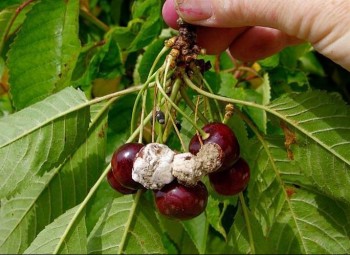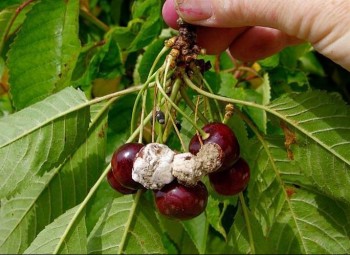Where does moniliosis begin?
Redness of the primary leaves at the end of spring is one of the signs of moniliosis on cherries. Brown spots appear on the secondary leaves when the infection is severe; when it is weak, the leaves remain green throughout the entire growing season, but from the end of August they also begin to turn brown and black dots of moniliosis infection appear on them.
The mycelium of the fungus can remain invisible in green leaves all summer. In cold and humid weather, the fungus severely affects the ovaries of the fruits, making them one-sided (ugly).
Spores resembling a “net” may appear on their surface. In rainy weather and if the fungicide is not applied in a timely manner, monilial cracks may appear on the fruits. In August, the fruits rot and become covered with monilial spore clusters (autumn form of the fungus). Rotting also occurs during storage.
The infection spreads most intensively on cherries in the spring, during the phase of bud formation and flowering. At this time, long rains and cool weather are dangerous.
Visible signs of the disease appear already at the end of flowering: the buds and flowers dry out. The mycelium of the fungus penetrates the skeletal branches, causing them to dry out. The death of fruit branches begins 2-3 weeks after flowering, accompanied by yellowing of the leaves. Treatment of moniliosis on cherries should begin as soon as the first signs of the disease are noticed.
How to treat cherry moniliosis
- Detailed pruning of trees to improve lighting and ventilation of the crown. Cutting out dried branches when the first signs of disease appear, then 30-40 days after flowering. They need to be cut out, including 10-15 cm of the healthy part. This will help prevent the spread of the disease.
- In the spring, in the green cone and pink bud phases, spraying with copper-containing preparations or Horus.
- In summer, when moniliosis develops strongly, especially in cool and rainy weather, it is necessary to spray with a tank mixture of Skora (2 ml per 10 liters of water) or Strobi (2 ml) + Planriz (15 ml).
- Resistance to disease is increased by NPK-balanced application of organic and mineral fertilizers.Excess nitrogen increases the harmfulness of fungal diseases, phosphorus and potassium reduce the susceptibility of shoots.
- Before flowering, during flowering and when the tree is in a depressed state, it is useful to carry out foliar feeding of cherry trees with moniliosis. In such trees, the vascular system is severely affected by fungal mycelium, especially in spring, when the pathogen is most active and sharply inhibits leaf growth. For foliar feeding, it is better to use a chelated form of fertilizer, which is better absorbed by the leaves.
Cherry varieties resistant to moniliosis
- Brunette;
- Chocolate girl;
- Turgenevka
- Bulatnikovskaya;
- alexa,
- Volochaevka;
- Novella;
- Miracle cherry
- Rastorguevskaya;
- In memory of Vavilov;
- Tamaris.
- Chosen One.
- Cossack woman
Unfortunately, these varieties can also be affected by moniliosis. Until now, cherries have not been developed that are completely resistant to this disease.
Watch a video about the prevention and treatment of monilial burns:



 CUCUMBERS NEVER GET SICK, I'VE BEEN USING ONLY THIS FOR 40 YEARS! I SHARE A SECRET WITH YOU, CUCUMBERS ARE LIKE THE PICTURE!
CUCUMBERS NEVER GET SICK, I'VE BEEN USING ONLY THIS FOR 40 YEARS! I SHARE A SECRET WITH YOU, CUCUMBERS ARE LIKE THE PICTURE! You can dig a bucket of potatoes from each bush. Do you think these are fairy tales? Watch the video
You can dig a bucket of potatoes from each bush. Do you think these are fairy tales? Watch the video
 How our fellow gardeners work in Korea. There is a lot to learn and just fun to watch.
How our fellow gardeners work in Korea. There is a lot to learn and just fun to watch. Eye trainer. The author claims that with daily viewing, vision is restored. They don't charge money for views.
Eye trainer. The author claims that with daily viewing, vision is restored. They don't charge money for views. A 3-ingredient cake recipe in 30 minutes is better than Napoleon. Simple and very tasty.
A 3-ingredient cake recipe in 30 minutes is better than Napoleon. Simple and very tasty. Therapeutic exercises for cervical osteochondrosis. A complete set of exercises.
Therapeutic exercises for cervical osteochondrosis. A complete set of exercises. Which indoor plants match your zodiac sign?
Which indoor plants match your zodiac sign? What about them? Excursion to German dachas.
What about them? Excursion to German dachas.